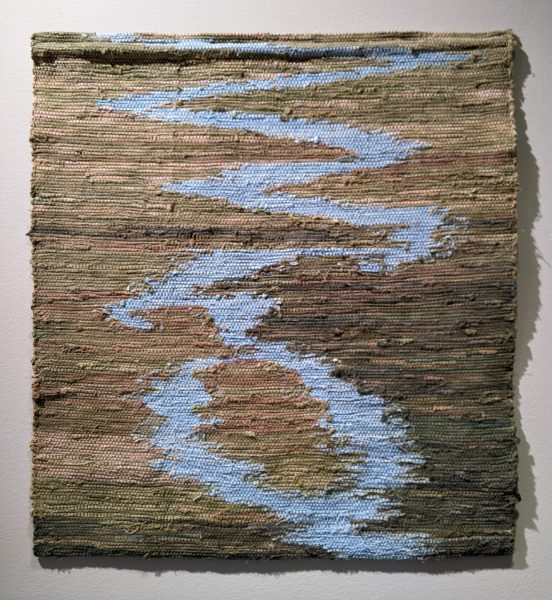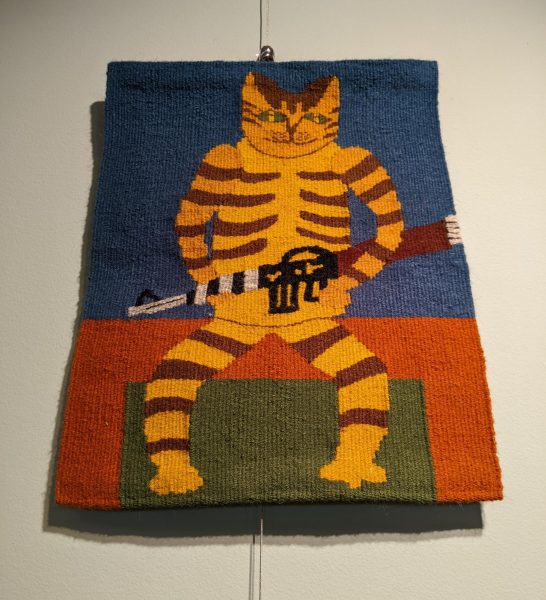As its name suggests, the new “Vibrant Traditions” exhibit at the Norway House shows how time-honored Scandinavian weaving practices are still full of life.
On display in the cultural center’s bright and airy Mondale Galleri until April 6, the exhibit puts contemporary twists on an assortment of traditional weaving techniques from Norway and Scandinavia.
“The graphic beauty of traditional Scandinavian textiles will never go out of style,” Robbie LaFleur, curator and longtime weaver, said. “This exhibition shows how artists are making it new and fresh. It’s not just old and historical.”
“Vibrant Traditions” is the result of a partnership between Norway House and the Scandinavian Weavers Study Group of the Weavers Guild of Minnesota, of which LaFleur has been a member for 25 years. Many of the exhibition’s works are by Study Group members.
LaFleur’s recreation of Edvard Munch’s iconic 1893 painting “The Scream” in the shaggy rya weaving technique welcomes visitors into the Galleri, an homage that is playful and eye-catching, but not scary.
With their intricate patterns and vivid colors, it’s difficult not to examine every detail of every piece in “Vibrant Traditions.”
Many pieces display geometric patterns more aligned with traditional Nordic sensibilities.
Others are more illustrative. The first piece to the right upon entering the Galleri by textile artist Mandy Pedigo is a rag rug depicting a flowing river that curves into an oxbow lake among a landscape of greens and browns.
The bumpiness of the weave evokes the unevenness of nature, absolutely perfect in its chaos.

There’s also a tapestry of a cat holding a machine gun.
Called “Terrorist Cat,” it was created by LaFleur’s mentor Lila Nelson, who passed away in 2015.
LaFleur said Nelson often brought humor and sharp political wit to her tapestries.
“We all know what a gun looks like, even if we don’t think about them or like to think about them,” LaFleur said.
The yellow tabby cat with stark brown stripes has an unnervingly unreadable smile, evoking the absurd and desensitizing nature of hyperviolent American culture.
It’s perhaps the most contemporary message conveyed in an exhibition filled with reimaginings of ancient craft forms.

The oldest of these forms is the warp-weighted loom that acts as the exhibition’s centerpiece.
On a warp-weighted loom, rocks are tied to the ends of the vertical threads to maintain equal tension throughout the piece being created. The earliest evidence of the loom’s existence dates back to 7,000 BCE in Palestine, according to a Galleri placard, and is thought to have arrived in Scandinavia by the third century C.E.
LaFleur said the loom will be used for periodic demonstrations by Study Group member Melba Granlund, to whom LaFleur originally sold the loom after it was made for her.
“A lot of people don’t even understand weaving in its simplest form, that over-under motion,” LaFleur said. “The demonstrations will make the process less mysterious.”
A smaller form of the loom that uses deer antlers as supports can be found on a table on the left side of the Galleri, hearkening back to the craft’s de-established roots.
Overall, LaFleur said she hopes “Vibrant Traditions” will inspire young people to explore the real world, outside of the digital.
“I spent my life sitting in front of a screen (as a reference librarian and Director of the Minnesota Legislative Reference Library),” she said. “Working in the real world with real materials saved me. It’s something that has been serving me my whole life.”
Norway House has hosted two previous exhibitions with the Study Group and is a natural home for “Vibrant Traditions,” as a cultural center that strives to connect people with contemporary Norway, not just the history of Norwegian immigration to Minnesota.
“Norway is a very forward-thinking country,” Hallow Maren Frid, Norway House’s communications coordinator, said.
Frid said the works in “Vibrant Traditions” could be “challenging your preconceived notions (about Norwegian culture) or broadening your horizons.”
Those preconceptions could be about who Norwegian people are and what they look like, but the Norway House makes it clear that everyone is welcome, regardless of heritage.
“Many East African people use our space,” Norway House Chief-of-Staff Max Stevenson said. “And there’s a big East African population in Norway. People from Somalia often go to Norway for school and then return, so we’ll have Somali people here who speak Norwegian or who maybe have a relative in Norway.”
Norway House is located in the Ventura Village neighborhood, a historically immigrant community where many Norwegians settled in the early 20th century and that is now home to East African and Latin immigrants too, as well as the American Indian Cultural Corridor.
Overall, Stevenson said that what makes Norway House special is their dedication to building a strong, diverse, egalitarian community that celebrates Nordic culture in Minnesota and beyond.
“What we want is for people to find their inner Nordic,” he said.














